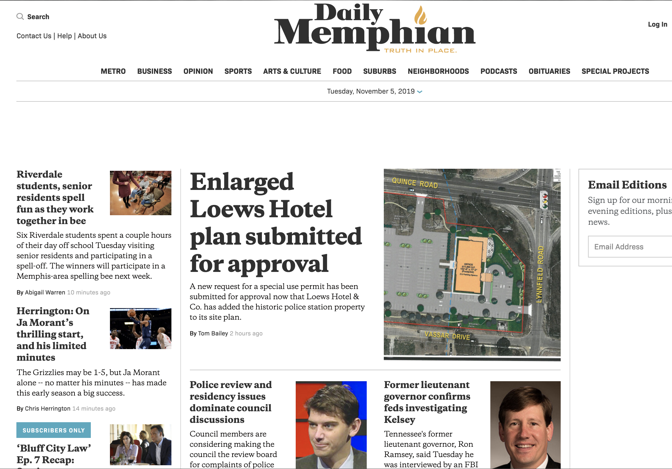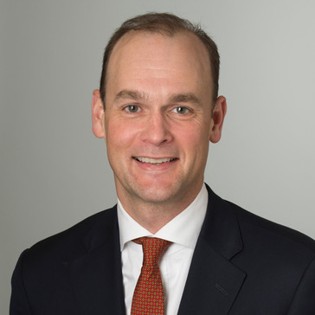It’s time for another look at new financial, editorial, and technological models for local journalism. You’ll find previous entries at these links: from Mississippi; from Maine; from Massachusetts; from Southern California and the San Francisco Bay Area; from Massachusetts again; from the Hudson Valley of New York; and from points beyond. They all involve efforts to revive existing news operations, invent additional ones, and replace organizations that are being starved out of relevance by their hedge-fund or private-equity chain owners.
Today we go to Memphis, Tennessee. This is of course the metropolis of western Tennessee, with the state of Mississippi just across the border to the south, and Arkansas just across the Mississippi River to the west. Memphis is the second-largest city in Tennessee, after Nashville. Its population is around 650,000—more than 60 percent African-American, about 30 percent white, and the rest a variety of others. On average its people are poor. The median household income for the United States is above $60,000, whereas in Memphis it is below $40,000.
The best known Memphis-based company is FedEx, which has operated there since the early 1970s. Other major operations include the St. Jude Children’s Research Hospital, and the AutoZone company. In 1956, local phenom Elvis Presley broke the local color line by performing alongside Ray Charles and B. B. King at a benefit for a black radio station. The National Civil Rights Museum in Memphis includes the site of the Lorraine Motel, where, on what I several times heard described as the worst day in the city’s history, Martin Luther King Jr. was murdered in 1968.
Through the ups and downs of the city’s modern evolution, its main morning newspaper, The Commercial Appeal, played an outsized regional role. “I’ve been around newspaper journalism since the 1970s, breathing it in as a kid before that,” Otis Sanford told me. Sanford grew up in northern Mississippi; worked as a reporter and editor for several papers including The Commercial Appeal; and has been a professor in the journalism department at the University of Memphis since 2011.
“Whether you liked the editorial opinions of The Commercial Appeal or not, it was of tremendous influence,” Sanford said. “You’d have to go to Atlanta to find comparable regional papers.”
The Commercial Appeal had been owned since the 1930s by the Scripps-Howard group. During the Great Extinction of local and regional papers over the past dozen years, the paper went through several changes of ownership, and is now part of Gannett.
Through this process, The Commercial Appeal shrank by all locally important measures: the size of its news staff, its circulation and influence, and even its connection to Memphis at all. Its printing plant moved out of town, 90 miles away to the city of Jackson, Tennessee. “Why did that matter?” Otis Sanford said to me. “That means earlier deadlines every day, so you can’t get any late-breaking news into the printed paper, or even late afternoon news.”
The overall spiral of contraction sounds similar to what has happened in many other areas. It was accelerated for The Commercial Appeal by Gannett’s decision to operate the paper as part of a statewide network of Tennessee coverage—in a state with very distinct regional identities and differences. “They were having people in Nashville write about Memphis,” Otis Sanford said. “People were hungry for something that was much more local.”
“This ‘Tennessee network’ branding was kind of the final straw,” Eric Barnes told me. Barnes is a prominent Memphis journalist, a novelist, and host of a popular weekly PBS news show. “West Tennessee doesn’t like East Tennessee, and they both don’t like the middle. Lumping them all together in a ‘network’ might make sense on a whiteboard in the headquarters, but it made no sense to people in Nashville [in the middle], or Knoxville [on the east], or Memphis [in the west].”
“Memphis is wildly proud, and we’ve also got a chip on our shoulder,” Andy Cates, who is CEO of a nationwide outdoor-resort company based in Memphis, told me. “We don’t get along with Nashville—it’s like Boston and New York. We think it’s incredibly important to have journalism about our community that is rooted in our community.”
That is the central idea behind a one-year-old online publication called The Daily Memphian. Eric Barnes is the CEO; Andy Cates is chairman of the board; Otis Sanford is a columnist; and together with some three dozen journalistic colleagues and many Memphis-area donors and supporters they are trying to bring locally based, serious journalism back to town.
Here is a summary of what I learned by talking with the three of them, by following news on their site, and by asking for judgments from other figures in Memphis.
What it is: The “paper” is an online-only, by-subscription news source, which began operations in September of 2018 after initially raising some $6.7 million in startup funds from local donors. Subscriptions are $7 per month, or $84 per year—with some news items provided outside the paywall and free or reduced-price offerings for schools and libraries and some other users.
According to Eric Barnes, the paper’s target was to attract 4,500 paying subscribers within its first year. It reached that target within three weeks and now has about 11,000 paying subscribers. “We’re not doing any dollar-a-week, dollar-a-month introductory offers,” he told me. “The churn rate”—people dropping subscriptions—“is less than 6 percent, and our web traffic is solid and growing.”
The Daily Memphian is owned by a new 501(c)3 non-profit, Memphis Fourth Estate Inc., which has no editorial control of its content. Memphis Fourth Estate continues to encourage donations toward the paper’s survival, and since the launch has raised another $1.5 million.
The paper’s total editorial staff is about 40, many of whom were familiar names in local journalism who came over from the declining Commercial Appeal or other publications.
Why it was started. The “About” page of the paper’s web site minces no words:
Frustrated by the gutting of local journalism in Memphis, a group of seasoned journalists, media professionals and concerned citizens gathered to discuss the need for strong, locally focused and locally produced daily news.
“People realized this was what it was like not to have a hometown paper,” Eric Barnes said, of the Memphis reaction when news operations shifted to the statewide network.
“We didn’t do this haphazardly,” Andy Cates told me. “We spent years exploring it,” as the local-news crisis in Memphis intensified. “We took the best journalists from The Commercial Appeal, and other stars from other publications. We realized that there was mounting anger, across the community, that a civic function that was so critical had gone so far down.”
How it’s paid for: According to Andy Cates, the $7 million raised for the Memphian is the largest-ever charitable investment in one city’s news organization. (The Texas Tribune, a well-known non-profit founded ten years ago, is a larger operation but covers an entire state.)
“It is like a political campaign,” Cates told me. “We have been to every Rotary meeting. We have gone to every church. We have spoken with every group that will listen to us. We have shaken hands, kissed babies, hugged people. We have asked everyone for support, and we have gotten it.”
The supporters include local foundations, corporations, and wealthy individuals and families. Cates and Barnes both stressed that donations went to the Memphian’s parent foundation, with no conditions or guidance accepted about its coverage.
“We think of this as ‘philanthropic venture capital,’” Cates said. “Question one to donors is, Do you believe that a healthy newspaper is important for a healthy community? And question two is, Given all of Memphis’s other needs, is this a high enough priority to be worth this much capital. The answer to both has been an overwhelming yes.”
Eric Barnes, whose background is in journalism rather than Cates’s in finance, stressed that while the paper was structured as a non-profit, its operating outlook is as a “real” business. “Our head of subscriptions, our marketing people, our ad people, we downplay that we are a nonprofit,” he said. “We want to become sustainable, which means getting to about 25,000 subscribers per year,” or a little more than twice the first-year level. “We try to run this like a business. Our goal is to put up high-level content, and have people pay for it.”
“People will pay for news,” Barnes said. “They did so for decades if not centuries. That the industry ever got away from that is a real historical anomaly.”
How it is being received across Memphis’s racial divide: Barnes and Cates, and most members of their board, are white. Most of Memphis’s population is black. What are its intentions for covering the area’s African-American community, and what have been its results?
As for intentions, Andy Cates said, “We’re very clear that if the entire community does not buy into this venture, and support it—if the entire community does not feel that its story is being told—then we have failed.”
Eric Barnes told me that when the site launched, he went to talk with a number of African-American church communities. “I said that one decision we made was, We weren’t going to feature coverage of ‘last night’s crime.’ Of course we’d cover crime trends, and not shy away from problems. But we weren’t going to splash out mug shots and be driven by the police blotter.” Barnes said he got applause for that line—but that a “wait and see” attitude understandably remained.
I asked Otis Sanford, one of the area’s best-known African-American journalists, who now writes a featured column for The Daily Memphian, about the site’s reach across the racial divide.
“I don’t think that The Daily Memphian has quite resonated yet with the African-American community,” he said. “That’s not to say it has not registered at all. But by and large it has not penetrated the market. They are working on it, and they are doing a relatively decent job so far.” Sanford’s own column is routinely one of the best-read on the site.
Why it all matters, outside Memphis: “We want to be known as the lab experiment of whether the Fourth Estate can flourish in Middle America,” Andy Cates told me. “We want to be a national model, but our mission is local.
“The life boats aren’t coming to save us. We have to do this ourselves. ”
Source link
 Black America Breaking News for the African American Community
Black America Breaking News for the African American Community




